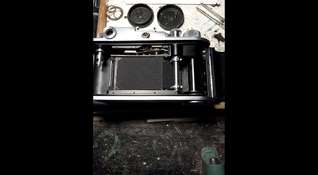Why One Might Prefer a Cloth FP Shutter.
The reason for starting this thread is to discuss experiences with shutter repair and mechanical camera longevity.
The following are some ideas based on observations in the 50 some years I have been using SLR cameras.
A few years ago, after getting more involved with mechanical SLR repair it was clear to me that not all mechanical SLRs are the same.
In fact, after studying repair literature on various cameras, I realized the benefits of the older horizontal cloth shutters.
In general, cloth FP shutters are integral to the body of the camera. For example, you usually can’t just take the shutter out as a unit. You have to disassemble all the pieces individually to ‘remove the shutter.’
Though this may seem a bad thing, the steps involved are similar across camera brands and the whole affair is well documented in the repair literature.
On the other hand, when manufacturers started installing metal, vertical shutters, these frequently came as an assembled unit from a shutter manufacturer (like Copal).
Although the specs of metal vertical shutters are the best in the business, the repair process for the shutters, in many cases, amounted to removal and replacement.
Now one might ask ‘where are all the new replacement vertical Copal shutters.’ And, of course there are none.
Clearly there are exceptions to these generalizations as some Copal shutters are well documented and some horizontal cloth shutters are nearly impossible to repair.
So, don’t discount cameras with cloth shutters, as they may indeed outlast the others.
Share your comments and stories.

The reason for starting this thread is to discuss experiences with shutter repair and mechanical camera longevity.
The following are some ideas based on observations in the 50 some years I have been using SLR cameras.
A few years ago, after getting more involved with mechanical SLR repair it was clear to me that not all mechanical SLRs are the same.
In fact, after studying repair literature on various cameras, I realized the benefits of the older horizontal cloth shutters.
In general, cloth FP shutters are integral to the body of the camera. For example, you usually can’t just take the shutter out as a unit. You have to disassemble all the pieces individually to ‘remove the shutter.’
Though this may seem a bad thing, the steps involved are similar across camera brands and the whole affair is well documented in the repair literature.
On the other hand, when manufacturers started installing metal, vertical shutters, these frequently came as an assembled unit from a shutter manufacturer (like Copal).
Although the specs of metal vertical shutters are the best in the business, the repair process for the shutters, in many cases, amounted to removal and replacement.
Now one might ask ‘where are all the new replacement vertical Copal shutters.’ And, of course there are none.
Clearly there are exceptions to these generalizations as some Copal shutters are well documented and some horizontal cloth shutters are nearly impossible to repair.
So, don’t discount cameras with cloth shutters, as they may indeed outlast the others.
Share your comments and stories.
Last edited:



